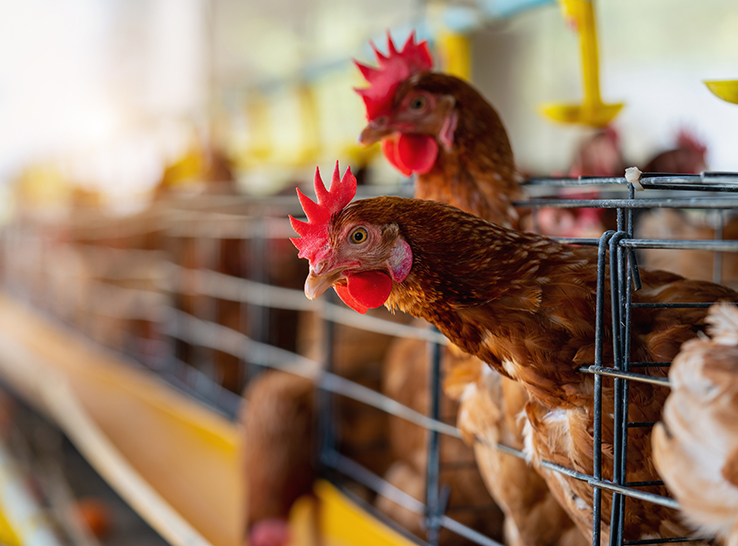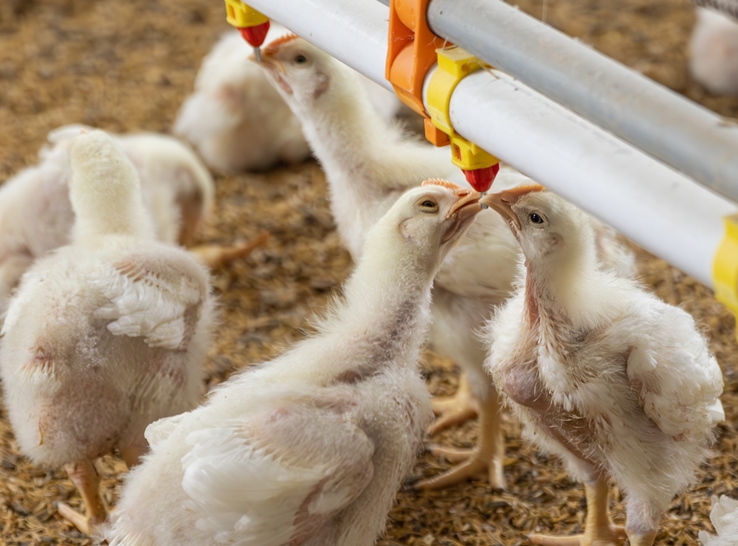Commercial egg-laying operations can benefit from more effective and economical ways to depopulate flocks at the end-of-lay while improving worker performance and maintaining or improving animal welfare.
On-farm research in Switzerland applied portable blue-light units and specialized crate carts, seeking to improve depopulation during catching, carrying and crating without changes to flock housing or other infrastructure.
However, neither the blue light nor the cart reduced layer stress-related responses or bone fractures, but such interventions were found to improve working conditions and worker efficiency without negative effects on hen welfare.
Unlike a broiler chicken operation harvesting several times per year, a layer farm may depopulate once per year or even less following a molting schedule. As a result, layer hen depopulation can be less standardized, less automated and potentially more problematic in terms of catching, carrying and crating (CCC).
There likely are higher costs per bird and greater risk of stress on birds, more bruising and bone fractures, and possible animal welfare concerns. Even professional catching crews may have to cope with less-than-ideal working conditions on certain farms, resulting in lower worker efficiency and possible welfare issues.
With cage-free layer operations on the rise – now at 34% of egg production in the US – the egg industry may benefit from new research into optimal layer depopulation techniques.
‘Improvements are still warranted’
Previous research identified the main sources of stress on hens related to CCC. Most bird injuries appeared to occur as a result of pulling hens by the legs or collisions with the cage “furniture.”
However, researchers in Switzerland found that the current CCC process resulted in a relatively low level of injury (e.g., 8.1% of hens) and not much stress on the birds (e.g., little change in glucocorticoid concentrations).
Nonetheless, the Swiss researchers stated that “improvements are still warranted,” particularly with respect to barn lighting and hen conveyance to transport vehicles.
Depopulation typically occurs under low-light conditions when hen activity and apparent stress are less. Yet, workers still need adequate illumination for CCC. Previous research suggests low-intensity light with a wavelength around 400 nm (blue light) can minimize unrest in the flock while allowing sufficient illumination for workers.
Not surprisingly, though, CCC also can cause hindered breathing in hens and, in extreme cases, suffocation. Minimizing the worker’s walking distance between catching and crating supports animal welfare and can increase the speed of depopulation.
Attempts to speed up CCC include bird conveyor belts and wheeled module systems. However, high start-up costs and maintenance discourage the installation of conveyor belts. Wheeled module systems have the advantages of not increasing bird bone fractures and bruises over conventional CCC while reducing the physical demands on workers.
Two separate interventions
In this study, researchers with the Center for Proper Housing: Poultry and Rabbits (ZTHZ) at the University of Bern, Switzerland, investigated two separate interventions to improve CCC of end-of-lay hens in Swiss commercial egg farms:
- Portable blue-light units for barn illumination
- Specialized wheeled carts to crate hens inside the barn or aviary for easy conveyance to the loading area outside
Researchers emphasized that commercial egg farms needed low-cost solutions for depopulation, solutions that required little or no change to barn structure. However, they cautioned that the farms in this study only represented a subset of egg producers with “a particular barn infrastructure” and not all Swiss egg producers.
This study involved more than a dozen farms that used a variety of cage-free, multi-tier aviary systems from three major suppliers (Big Dutchman, Chore-Time, Facco). They also used a variety of hybrid brown feather and white feather birds (H&N International, Lohman), with some flocks consisting of multiple hybrids. Hens ranged from 72 to 112 weeks of age (n = 905) with the oldest flock having been molted.
The blue light-versus-control experiment involved 10 farms, whereas the cart-versus-control experiment involved three farms.
On each farm, researchers collected data on stress (respiration rate and cloacal and comb temperatures), fearfulness (tonic immobility or death feigning) and injury (fractures and dislocations), with baseline measurements made approximately 90 minutes prior to depopulation. They compared blue-light and cart treatments only versus an on-site control.
The researchers had custom designed and fabricated both the portable LED blue light units, complete with hanging hooks and magnetic bases, and the four-wheel, welded metal carts built to convey standard-size crates used for commercial laying hen depopulation transport.
Enable to reduce bird stress
In this study, in contrast to the researchers’ hypothesis and previous work by this team, the blue-light treatment was unable to reduce bird stress indicators (respiration rate and comb and cloaca temperatures). Nor did it reduce fearfulness.
However, control hens were about twice as likely to sustain a fracture compared to those depopulated under blue light (11.29% vs. 6.69%), although the small sample size did not permit statistical analysis.
“Placement of the lamps and other lighting-associated traits,” the researchers noted, “were not only important in regard to potential effects on hens but also for the workforce.”
It turns out that crating onto specialized carts inside the barn – versus crating outside onto a pallet or directly into a trailer or truck – may cause more collisions with the crate frame and increase clumping of hens.
Also, the researchers note, Swiss family workers that get together to depopulate once per year are likely to have less practice and expertise than professionals depopulating several farms each week.
At any rate, the researchers found that the use of carts did not reduce bird stress as shown by respiration rate or comb and cloacal temperature. While there was an initial reduction in fearfulness, there was no reduction in “latency,” which is the recovery period from tonic immobility.
Nonetheless, the researchers reported: “Hens were less fearful when they were crated immediately (using carts) compared to carrying them to the crating areas first.”
However, they also suggested that the potential benefits of carts may “only arise over time as farmers and workers become more familiar with the methodology.”
Overall in this study, the use of blue lights or carts did not improve hen welfare, but these interventions did improve working conditions.
What does study mean for producers?
- When it comes to end-of-lay depopulation, using blue-light illumination or in-barn crating with carts, train workers first and test any new technology or procedures
- In adopting such interventions, be aware that layer welfare benefits may only accrue over time and some may simply be due to better working conditions
The full paper, titled “Solutions to improve the catching, handling, and crating as part of the depopulation process of end of lay hens,” can be found in The Journal of Applied Poultry Research and online here.
Editor’s note: Content on Modern Poultry’s Industry Insights pages is provided and/or commissioned by our sponsors, who assume full responsibility for its accuracy and compliance.








